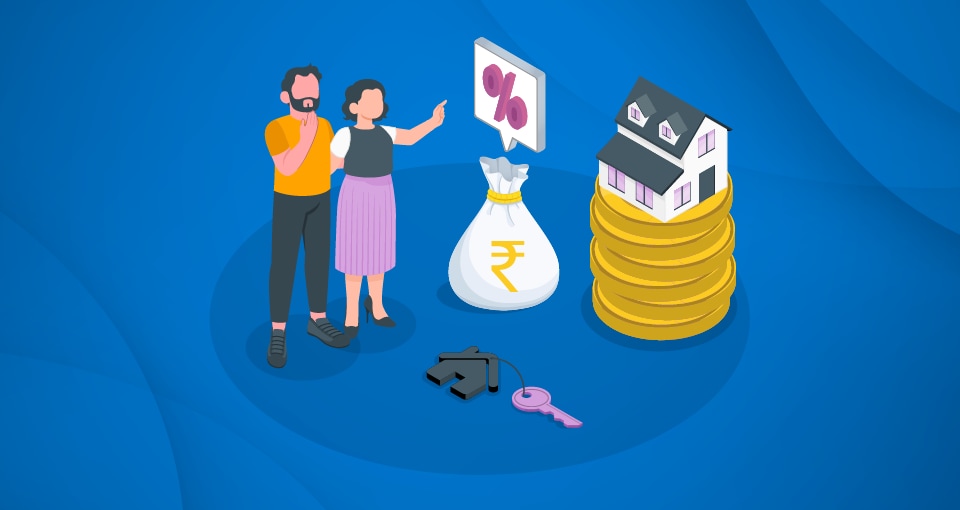Here's What You Should Know about Repo-linked Home Loans

When it comes to home loans, understanding the interest rates can feel like an intricate puzzle. Terms like Repo Linked Lending Rate (RLLR) and Marginal Cost of Fund Based Lending Rate (MCLR) can boggle the mind. But don't fret; go over this detailed guide to decode it all and make your home loan experience a smooth one!
Repo-Linked Lending Rates (RLLR)
Banks require funds for lending, just as you need loans for your dream home. They can accumulate funds from the public's deposits and borrow from the central bank. However, just as you pay interest on your loan, financial institutions must pay interest when they borrow from the central bank. This interest is known as the 'repo rate.'
But what's a 'repo'? It's short for 'repurchasing option' or 'repurchase agreement.' In this arrangement, scheduled commercial banks offer securities such as treasury bills or gold to the Reserve Bank of India (RBI) in exchange for overnight credit in case of liquidity shortages.
So, how is the RLLR calculated? It's simple: RLLR = Repo Rate + Spread. The ‘Repo Rate’ is the interest rate at which banks borrow from the RBI, and the ‘Spread’ is an additional percentage banks add to cover their operational costs and profit.
How does the Repo Rate Function?
The RBI manages the repo rate to regulate inflation and liquidity in the economy and conducts auctions for lending money to banks. Banks pledge government securities as collateral to borrow money from the RBI.
When the RBI lowers the repo rate, it signals a desire to boost liquidity in the economy. Lower repo rates mean cheaper borrowing for banks, encouraging them to lend more to individuals and businesses.
Conversely, if the RBI raises repo rates, banks find it more expensive to borrow, which leads to reduced lending. Hence, fluctuations in the repo rate also affects other interest rates in the financial system. These include personal loans, home loans, and business loans.
What is the Reverse Repo Rate?
The reverse repo rate is the rate at which banks lend money to the central bank. The RBI uses this tool to manage inflation levels by absorbing excess liquidity from the banking system. By increasing the interest rate, the central bank encourages financial institutions to lend money to them. This helps to reduce excess funds present in the economy.
Repo Rate's Impact on Home Loans
When the RBI lowers repo rates, borrowers get a respite as it reduces their borrowing costs. Banks are expected to pass on these savings to consumers. Banks should promptly adjust their interest rates in line with the repo rate changes. However, this turns out to be a one-way street – when the RBI raises the repo rate, banks tend to react instantly by increasing their interest rates on home loans.
However, this only holds true for rate hikes. Banks are often sluggish when it comes to lowering their lending rates, when the repo rate goes down. Since October 2019, many banks have started linking their home loan interest rates to the repo rate. This move promises quicker transmission of changes in RBI policy, ensuring that consumers get the corresponding benefit sooner.
Also Read: Choosing between Banks and NBFCs: The Right Partner for Your Home Loan
The Marginal Cost of Funds Based Lending Rate
RBI introduced the Marginal Cost of Funds Based Lending Rate (MCLR) in 2016 as the minimum interest rate charged by banks for specific loans. It's like an internal benchmark that guides the interest rates for loans. The goal here is to pass on the benefits of rate cuts to borrowers more efficiently.
In the past, when the RBI reduced the repo rate, it took banks quite a while to reflect these changes in the lending rates offered to borrowers. This changed under the MCLR regime, where banks have to adjust their interest rates in tandem with changes to the repo rate. The MCLR system aims to make banks more transparent about how they calculate interest rates for loans.
Should You Switch from Base Rate to MCLR?
The RBI mandates that banks should allow borrowers to switch from the base rate to MCLR when there's a change in the policy rate. However, it's crucial to get professional advice before making the switch, as it can impact your home loan tenure. For some borrowers, moving to MCLR may lead to more fluctuations in interest rates since banks can change MCLR values frequently.
Latest Developments on Repo-Linked Lending Rates
As of February 8, 2023, the Monetary Policy Committee (MPC) decided to raise the repo rate by 0.25% to 6.50%. The reverse repo rate remained at 3.35%. The new rates for the bank and the marginal standing facility were 5.15% and 6.75%, respectively.
In the bi-monthly meeting on June 8, 2023, the MPC maintained the repo rate at 6.50%. Five out of the six members voted to continue the monetary policy stance of withdrawing accommodation to tackle inflation within its 4% comfort level while supporting growth.
On August 10, 2023, the MPC once again decided to maintain the repo rate at 6.50% but raised the inflation outlook for the July-September quarter to 6.2%. In its October review meeting, the MPC again decided to hold the policy repo rate at 6.5%, thus maintaining the status quo for the fourth straight time.
Understanding the intricacies of RLLR and MCLR can significantly impact your home loan experience. With the right knowledge, you can make informed decisions about the type of home loan that best suits your needs. Armed with this knowledge, purchase the house of your dreams in the easiest way with a Home Loan on Bajaj Markets. Ensure you have the best lending experience with features like pre-approved offers, instant approvals, flexible tenures, and more!
Blog Categories
Enter Your OTP



